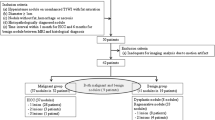Abstract
Differentiation of hepatic tumors is often evaluated in terms of qualitative diagnostic performance. The signal intensity patterns of hepatic masses are known to differ on certain T2-weighted imaging sequences. In this study, we investigated the quantitative analysis of hepatic masses by using an index called the “T2-shine ratio.” Fast-spin-echo (FSE), half-Fourier acquisition single-shot turbo spin echo (HASTE), and true-FISP sequences obtained with quick-imaging techniques during a single breath-hold were examined in 74 patients. T2-shine ratios were calculated by use of the signals of regions of interest (ROIs) placed on a tumor and peripheral tissue: the T2-shine ratio is defined as (tumor signal-liver signal)/liver signal. The rate of change in the T2-shine ratio was compared among three sequences of FSE, HASTE, and true-FISP. The T2-shine ratio of FSE deducted from HASTE was significantly higher for hepatic cysts than for other masses. The T2-shine ratio of HASTE deducted from True-FISP was less than zero for hemangioma. For the value that deducted the T2-shine ratio of HASTE from the T2-shine ratio of true-FISP, hemangiomas had a significantly lower value than did cysts and metastases (P < 0.05), but there was no significant difference from hepatocellular carcinomas (HCCs). Although liver cysts, cavernous hemangiomas, and other lesions could be differentiated, it was virtually impossible to distinguish HCCs from metastatic tumors. In conclusion, the quantitative analysis of hepatic tumors was able to differentiate among these lesions by use of the T2-shine ratio.



Similar content being viewed by others
References
Ohtomo K, Itai Y, Furui S, Yashiro N, Yoshikawa K, Iio M. Hepatic tumors: differentiation by transverse relaxation time (T2) of magnetic resonance imaging. Radiology. 1985;155:421–3.
Kim YH, Saini S, Blake MA, Harisinghani M, Chiou YY, Lee WJ, et al. Distinguishing hepatic metastases from hemangiomas. J Comput Assist Tomogr. 2005;29(5):571–9.
Li W, Nissenbaum MA, Stehling MK, Goldmann A, Edelman RR. Differentiation between hemangiomas and cysts of the liver with nonenhanced MR imaging: efficacy of T2 values at 1.5 T. J Magn Reson Imaging. 1993;3:800–2.
McFarland EG, Mayo-Smith WW, Saini S, Hahn PF, Goldberg MA, Lee MJ. Hepatic hemangiomas and malignant tumors: improved differentiation with heavily T2-weighted conventional spin-echo MR imaging. Radiology. 1994;193:43–7.
Naganawa S, Jenner G, Cooper TG, Potchen EJ, Ishigaki T. Rapid imaging of the liver: comparison of 12 techniques for single breath-hold whole volume acquisition. Radiat Med. 1994;12(6):255–61.
Ohtomo K, Itai Y, Yoshikawa K, Kokubo T, Yashiro N, Iio M, et al. Hepatic tumors: dynamic MR imaging. Radiology. 1987;163:27–31.
Mahfouz AE, Hamm B, Taupitz M, Wolf KJ. Hypervascular Liver Lesion: Differentiation of focal nodular hyperplasia from malignant tumors with dynamic gadolinium-enhanced MR imaging. Radiology. 1993;186:133–8.
Arbab AS, Ichikawa T, Sou H, Akaki T, Nakajima H, Ishigame K, et al. Ferumoxides-enhanced double echo T2-weighted MR imaging in differentiating metastases from nonsolid benign lesions of the liver. Radiology. 2002;225:151–8.
Kumano S, Murakami T, Kim T, Hori M, Okada A, Sugiura T, et al. Using superparamagnetic iron oxide-enhanced MRI to differentiate metastatic hepatic tumors and nonsolid benign lesions. AJR. 2003;181:1335–9.
Schoenigr CP, Koepke J, Gueckel F, Sturm J, Georgi M. MRI with superparamagnetic iron oxide: efficacy in the detection and characterization of focal hepatic lesions. J Magn Reson Imaging. 1999;17(3):383–92.
Mori K, Yoshida H, Itai Y, Okamoto Y, Mori H, Takahashi N, et al. Arterioportal shunts in cirrhotic patients: evaluation of the difference between tumorous and nontumorous arterioportal shunts on MR imaging with superparamagnetic iron oxide. AJR. 2000;175:1659–64.
Paley MR, Mergo PJ, Torres GM, Ros PR. Characterization of focal hepatic lesions with ferumoxides-enhanced T2-weighted MR imaging. AJR. 2000;175:159–63.
Vogl TJ, Hammerstingl R, Schwarz W, Mack MG, Muller PK, Pegions W, et al. Superparamagnetic iron oxide-enhanced versus gadolinium-enhanced MR imagiug. Radiology. 1996;198:881–7.
Author information
Authors and Affiliations
Corresponding author
About this article
Cite this article
Ogura, A., Hayakawa, K., Miyati, T. et al. Differentiation of hepatic tumors by use of image contrast with T2-weighted MRI. Radiol Phys Technol 2, 54–57 (2009). https://doi.org/10.1007/s12194-008-0043-0
Received:
Revised:
Accepted:
Published:
Issue Date:
DOI: https://doi.org/10.1007/s12194-008-0043-0




